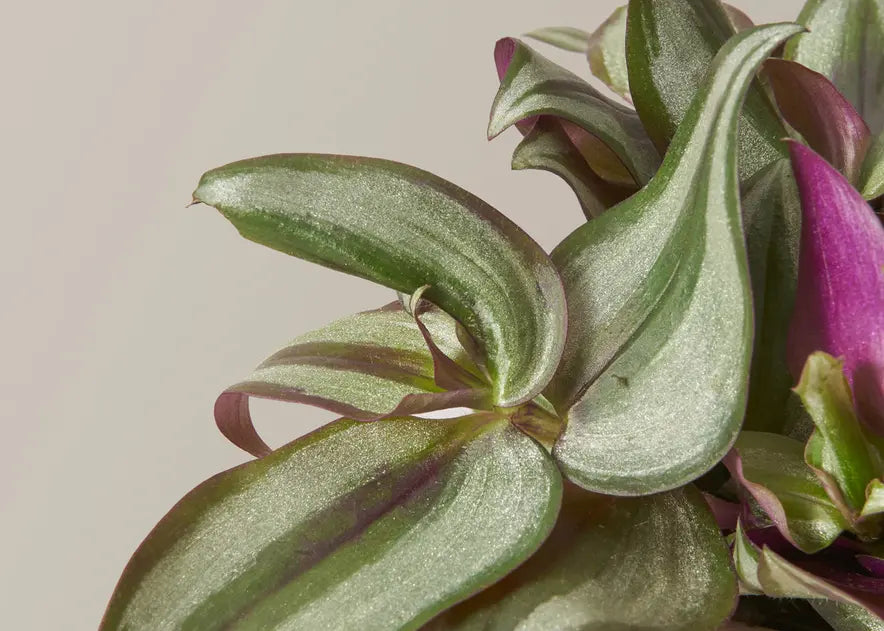
Plants 101
How to Care for a Tradescantia
Learn how to create the best growing conditions for a Tradescantia, also known as the inch plant.

Tradescantia is a genus of plants that includes a wide range of species. It is commonly referred to as "Wandering Jew", "inch plant" or "Spiderwort" due to its fast growth and tendency to spread out. This genus of plants originated in Central and South America and are known for their vibrant and colorful foliage.
Types of Tradescantia
Some common types of Tradescantia that are kept as indoor houseplants include:
- Tradescantia zebrina (Zebra Plant)
- Tradescantia fluminensis (Small-leaf Spiderwort)
- Tradescantia pallida (Purple Heart)
- Tradescantia Callisia Repens (Pink Panther)
- Tradescantia spathacea (Oyster Plant)

Sunlight
Tradescantia plants prefer bright, indirect sunlight. They can tolerate some direct sun but too much can scorch their leaves. It'll be ideal to keep this species in an East or West facing window, or a diffused South window. Nothern exposure will only provide low-moderate indirect light so some legginess may occur unless a grow light is incorporated. If you're not sure if your space will provide enough light, consider measuring light to ensure your Tradescantia will receive enough!
Water
Tradescantia plants like to be kept moist but not waterlogged. Water your plant once about half the soil has dried out between waterings. Expect to water more often in brighter light and less often in lower light.
During the summer months, you may need to water your plant more frequently than during the Winter months. Do not let the soil dry out completely as this can lead to wilting and leaf drop. You can utilize a moisture meter to help you properly gauage soil moisture and avoid overwatering!
Humidity
Tradescantia plants prefer higher humidity but can tolerate normal household humidity levels between 20-30%. If needed, you can increase the humidity around your plant by placing it on a wet pebble tray or using a humidifier which is the most effective way to localize humidity. Not sure how much humidity is in a room? You can measure the level of humidity with a hygrometer or the LTH meter.
Temperature
Tradescantia plants prefer temperatures between 60-75°F (15-24°C). Avoid placing your plant near drafty windows, doors or in front of AC or heating units as sudden drops in temperature or fluctuating drafts can cause leaf drop.
Soil
Tradescantia plants prefer a well-draining potting mix when being freshly planted into a new container. If increased drainage is desired, you can add perlite or sand to the soil mix to allow for more aeration and drainage within the soil. Keep in mind, with the more drainage you add the capacity of the soils volume to hold water will decrease and you may need to water more frequently.
Propagation
To propagate Tradescantia, you can take stem cuttings of about 4-6 inches in length. Remove lower leaves which helps to expose nodes and place the cuttings in a jar of water or moist potting mix. Be sure no leaves are below the water level or soil as it will rot.
Keep in bright, indirect light and top off your water vessel once it gets low. If soil propagating, rewater the cuttings once the top 2-3 inches of soil have dried. Roots usually develop within 2-4 weeks, and once the roots get about 2-3 inches in length you can pot up the new plants into a container with fresh potting mix.
Common Problems
Some common problems with Tradescantia plants include:
SYMPTOM: Leggy and loss of color
CAUSE: Not enough light
SYMPTOM: Browning
CAUSE: Underwatered, low humidity, or too much direct sunlight
SYMPTOM: Yellowing, moist potting mix
CAUSE: Overwatering
Precautions
Tradescantia plants can be toxic to cats, dogs and humans if ingested in large quantities. Keep your plant out of reach of pets and children.

Words By The Sill
Empowering all people to be plant people—a collection of articles from The Sill's team of plant experts across a variety of plant care topics to inspire confidence in the next generation of plant parents. Welcome to Plant Parenthood™.
Do Some Plant Shopping